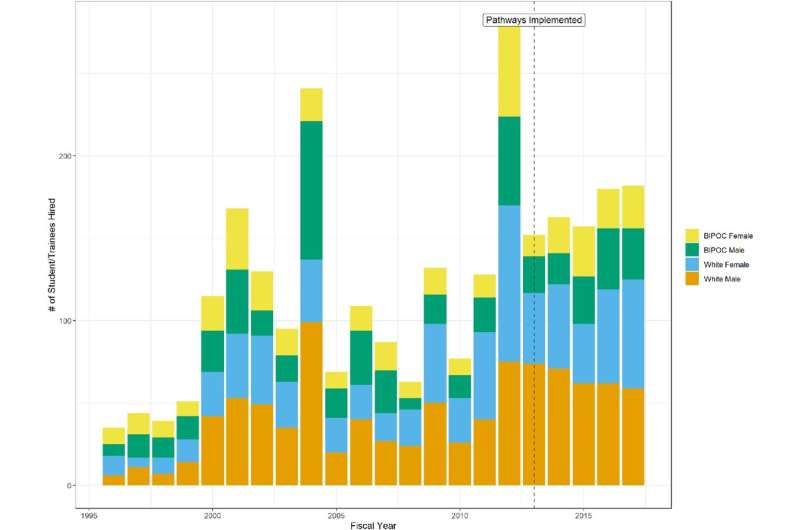Number of student and recent graduate trainees entering USDA forest service between 1996 and 2017. Credit: PLOS ONE (2022). DOI: 10.1371/journal.pone.0277423
A growing number of student and recent graduate trainee and internship programs have been implemented over the last few decades as one potential solution to address the underrepresentation of women and Black, Indigenous, and People of Color (BIPOC) in science and natural resource management institutions. However, data on the effectiveness of this strategy is scarce.
A team of researchers from the United States Department of Agriculture (USDA) Forest Service and a University of Minnesota faculty member, Michael Dockry, conducted a rare study on this topic, using information from a comprehensive employee dataset from the USDA Forest Service, which has the largest natural resource management workforce in the country.
Their findings were recently published in the journal PLOS One. The evaluation suggests that, while internship employment programs can be an effective tool for hiring a diverse workforce, they are not sufficient to close the overall workforce diversity gap.
First author Michael Dockry, Ph.D., an assistant professor in the Department of Forest Resources at the University of Minnesota, worked with the team of researchers to analyze the demographic characteristics and career paths of paid interns from 1996 to 2017.
The researchers found:
- The majority of employees who started as interns later converted to permanent employment with the USDA Forest Service, but only 2% of the total employees within the agency were former interns.
- People who started as interns had significantly shorter USDA Forest Service careers than those who started in permanent positions.
- Black and Hispanic interns were, respectively, five and three times more likely than white interns to work for the agency in permanent positions after their internships.
- Male BIPOC employees who started as interns were fired at significantly higher rates than all other employees.
- White women entering directly into permanent positions typically advanced to higher pay grades through promotion faster than white women who entered as interns.
These findings suggest that internship employment programs insufficiently address the workforce diversity gap. To achieve a level of representation that mirrors the civilian labor force, this study suggests that internship programs need to focus on long-term employee retention and be of significantly larger scale.
"STEM fields in general, and natural resource fields specifically, have not reflected the diversity of our society. This study is important because it gives us insights into building institutions that are more reflective of society as well as improved science and natural resource management. While these findings seem limited to one agency, there are many lessons from this work that we can learn about creating a diverse workforce," said Dockry.
As for next steps, the researchers hope to uncover why interns had significantly shorter careers than those who started in permanent positions with the U.S. Forest Service. They will also work to understand how universities can work with natural resource agencies to continue to improve diversity, equity and inclusion in internship opportunities that lead to longer retention of employees in a more diverse workforce.
More information: Michael J. Dockry et al, Student trainee and paid internship programs have positive results but do little to influence long-term employee diversity in the USDA forest service, PLOS ONE (2022). DOI: 10.1371/journal.pone.0277423
Journal information: PLoS ONE
Provided by University of Minnesota






















